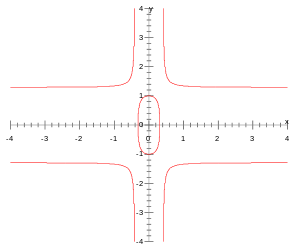Twisted Edwards curve

In algebraic geometry, the Twisted Edwards curves are plane models of elliptic curves, a generalisation of Edwards curves introduced by Bernstein et al. (2007) and named after Harold M. Edwards. Elliptic curves are important in public key cryptography and Twisted Edwards curves are at the heart of an electronic signature scheme called EdDSA that offers high performance while avoiding security problems that have surfaced in other digital signature schemes.
Each twisted Edwards curve (as the name suggests) is a twist of an Edwards curve. A twisted Edwards curve E E,a,d over a field K which have char(K)≠2 is an affine plane curve defined by the equation:
- E E,a,d:
where a, d are distinct non-zero elements of K. An Edwards curve is a twisted Edwards curve with a = 1.
Every twisted Edward curve is birationally equivalent to an elliptic curve in Montgomery form and vice versa.
Group law
As for all elliptic curves, also for the Twisted Edwards curve, it is possible to do some operations between its points, such as adding two of them or doubling (or tripling) one. The results of these operations are always points that belong to the curve itself. In the following sections some formulas are given to obtain the coordinates of a point resulted from an addition between two other points (addition), or the coordinates of point resulted from a doubling of a single point on a curve.
Addition on Twisted Edward curves
Let K be a field with characteristic different from 2. Let and be points on the Twisted Edward curve. The equation of Twisted Edward curve is written as;
EE,a,d: .
The sum of these points on EE,a,d is:
The neutral element is (0,1) and the negative of is (
These formulas also work for doubling. If a is a square in K and d is a non-square in K, these formulas are complete: this means that they can be used for all pairs of points without exceptions; so they work for doubling as well, and neutral elements and negatives are accepted as inputs.[1]
Example of addition
Given the following Twisted Edwards curve with a=3 and d=2:
it is possible to add the points and using the formula given above. The result is a point P3 that has coordinates:
.
Doubling on Twisted Edward curves
Doubling can be performed with exactly the same formula as addition. Doubling of a point (x1,y1) on the curve EE,a,d is:
[2](x1,y1) = (x3,y3)
where
Example of doubling
Considering the same twisted Edwards curve given in the previous example, with a=3 and d=2, it is possible to double the point . The point 2P1 obtained using the formula above has the following coordinates:
It is easy to see, with some little computations, that the point belongs to the curve .
Extended coordinates
There is another kind of coordinate system with which a point in the Twisted Edwards curves can be represented. A point on is represented as X, Y, Z, T satisfying the following equations x=X/Z, y=Y/Z, xy=T/Z.
The coordinates of the point (X:Y:Z:T) are called the extended Twisted Edward coordinates. The identity element is represented by (0:1:1:0). The negative of a point is (-X:Y:Z:-T).
Inverted Twisted Edwards Coordinates
The coordinates of the point are called the inverted twisted Edwards coordinates on the curve with ≠0; this point to the affine one on EE,a,d. Bernstein and Lange introduced these inverted coordinates, for the case a=1 and observed that the coordinates save time in addition.
Projective twisted Edward coordinates
The equation for the Projective Twisted Edwards Curve is given as: For Z1≠0 the point (X1:Y1:Z1) represents the affine point (x1= X1/Z1, y1= Y1/Z1) on EE,a,d.
Expressing an elliptic curve in twisted Edwards form saves time in arithmetic, even when the same curve can be expressed in the Edwards form. To know more about the speeds of addition and doubling in projective coordinates on Edwards curves, standard coordinates on twisted Edward curves, inverted coordinates on Edwards curves and inverted coordinates on twisted Edwards curves refer to the table in:
http://hyperelliptic.org/EFD/g1p/auto-twisted-extended-1.html
Addition in Projective Twisted curves
The addition on a projective twisted Edwards curve is given by:
- (X3:Y3:Z3)= (X1:Y1:Z1)+(X2:Y2:Z2)
and it costs 10Multiplications + 1Squaring + 2D + 7 additions, where the 2D are one multiplication by a and one by d.
- Algorithm
- A= Z1.Z2,
- B=A2
- C=X1.X2
- D=Y1.Y2
- E=dC.D
- F=B-E
- G=B+E
- X3= A.F((X1+Y1).(X2+Y2)-C-D)
- Y3=A.G.(D-aC)
- Z3=F.G[2]
Doubling on projective twisted curves
Doubling on the projective twisted curve is given by:
- (X3:Y3:Z3)= 2(X1:Y1:Z1)
This costs 3Multiplications+4Squarings+1D+7additions where 1D is a multiplication by a
- Algorithm
- B=(X1+Y1)2
- C= X12
- D=Y12
- E=aC
- F= E+D
- H=Z12
- J=F-2H
- X3=(B-C-D).J
- Y3=F.(E-D)
- Z3= F.J[2]
See also
- EdDSA
- For more information about the running-time required in a specific case, see Table of costs of operations in elliptic curves.
Notes
References
- Daniel J. Bernstein; Marc Joye; Tanja Lange; Peter Birkner; Christiane Peters, Twisted Edwards Curves (PDF)
- Huseyin Hisil, Kenneth Wong, Gary Carter, Ed Dawson., Twisted Edwards Curves revisited
- Daniel J. Bernstein; Tanja Lange; Peter Birkner; Christiane Peters, ECM using Edward curves (PDF)
External links
- http://hyperelliptic.org/EFD/g1p/index.html
- http://hyperelliptic.org/EFD/g1p/auto-twisted.html
- The Ed25519 algorithm: http://ed25519.cr.yp.to/